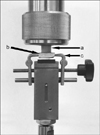Abstract
Purpose
The objective of this study was to compare the bonding strength between cement and an implant according to the cementing time.
Materials and Methods
The two types of cement used were CMW® 1 and 3 (Depuy Ltd., Blackpool, UK). Plastic molds containing CMW® 1 were pressed onto metal blocks at 2, 4, 5 or 6 minutes after mixing the cement, while molds containing CMW® 3 were pressed onto blocks at 3, 5, 6 or 7 minutes after mixing the cement. Tensile strength was tested with using an Instron Model 8874 (Instron Corp., Canton, MA, USA). Tensile strengths were compared using the Kruskal-Wallis test and the Mann-Whitney U test.
Figures and Tables
 | Fig. 1Basic materials for testing the tensile force between cement and a metal block (A: metal block, B: plastic tube, C: test material after cementing within the plastic tube, D: test material after removing the plastic tube). |
 | Fig. 2The method to test the tensile strength between cement and a metal block (a; cement, b; metal block, c; block holder). |
 | Fig. 3Graph of the mean tensile bonding strength of CMW® 1 cement over time after mixing. The error bars represent the standard error. |
References
2. Fehring TK, Mason JB. Scott WN, editor. Cemented total knee replacement: the gold standard. Surgery of the knee. 2006. 4th ed. Philadelphia: Churchill Livingstone;1626–1630.
3. Fischer H, Wirtz DC, Weber M, Neuss M, Niethard FU, Marx R. Improvement of the long-term adhesive strength between metal stem and polymethylmethacrylate bone cement by a silica/silane interlayer system. J Biomed Mater Res. 2001. 57:413–418.

4. Friedman RJ, Poss R. Revision total knee arthroplasty in patients with osteoarthritis. Rheum Dis Clin North Am. 1988. 14:537–544.

5. Goldring SR, Jasty M, Roelke MS, Rourke CM, Bringhurst FR, Harris WH. Formation of a synovial-like membrane at the bone-cement interface Its role in bone resorption and implant loosening after total hip replacement. Arthritis Rheum. 1986. 29:836–842.

6. Haas SS, Brauer GM, Dickson G. A characterization of polymethylmethacrylate bone cement. J Bone Joint Surg Am. 1975. 57:380–391.

7. Han HS, Kang SB, Yoon KS. High incidence of loosening of the femoral component in legacy posterior stabilised-flex total knee replacement. J Bone Joint Surg Br. 2007. 89:1457–1461.

8. Harper EJ, Braden M, Bonfield W. Mechanical properties of hydroxyapatite reinforced poly(ethylmethacrylate) bone cement after immersion in a physiological solution: influence of a silane coupling agent. J Mater Sci Mater Med. 2000. 11:491–497.
9. Iesaka K, Jaffe WL, Kummer FJ. Effects of preheating of hip prostheses on the stem-cement interface. J Bone Joint Surg Am. 2003. 85:421–427.

10. Insall JN. Revision of total knee replacement. Instr Course Lect. 1986. 35:290–296.
11. Jasty M, Maloney WJ, Bragdon CR, Haire T, Harris WH. Histomorphological studies of the long-term skeletal responses to well fixed cemented femoral components. J Bone Joint Surg Am. 1990. 72:1220–1229.

12. Jasty M, Maloney WJ, Bragdon CR, O'Connor DO, Haire T, Harris WH. The initiation of failure in cemented femoral components of hip arthroplasties. J Bone Joint Surg Br. 1991. 73:551–558.

13. Klein RW, Scott CP, Higham PA. The strength of acrylic bone cement cured under thumb pressure. Biomaterials. 2004. 25:943–947.

14. Maloney WJ, Jasty M, Burke DW, et al. Biomechanical and histologic investigation of cemented total hip arthroplasties. A study of autopsy-retrieved femurs after in vivo cycling. Clin Orthop Relat Res. 1989. 249:129–140.
15. Mikulak SA, Mahoney OM, dela Rosa MA, Schmalzried TP. Loosening and osteolysis with the press-fit condylar posterior-cruciate-substituting total knee replacement. J Bone Joint Surg Am. 2001. 83:398–403.

16. Mumme T, Marx R, Müller-Rath R, Siebert CH, Wirtz DC. Surface coating to improve the metal-cement bonding in cemented femur stems. Arch Orthop Trauma Surg. 2007.

17. Robinson RP, Lovell TP, Green TM, Bailey GA. Early femoral component loosening in DF-80 total hip arthroplasty. J Arthroplasty. 1989. 4:55–64.

18. Stauffer RN. Ten-year follow-up study of total hip replacement. J Bone Joint Surg Am. 1982. 64:983–990.

19. Vince KG. Revision knee arthroplasty technique. Instr Course Lect. 1993. 42:325–339.
20. Willert HG, Ludwig J, Semlitsch M. Reaction of bone to methacrylate after hip arthroplasty: a long-term gross, light microscopic, and scanning electron microscopic study. J Bone Joint Surg Am. 1974. 56:1368–1382.




 PDF
PDF ePub
ePub Citation
Citation Print
Print





 XML Download
XML Download